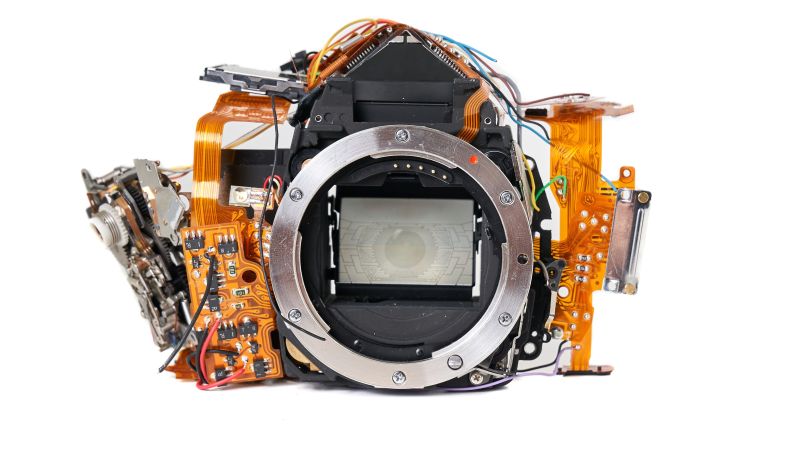Join us on Wednesday, May 29 at noon Pacific for the Camera and Lens Repair Hack Chat with Anthony Kouttron!
Unlike the normies, most of us are pretty comfortable looking under the hood of just about anything electronic or mechanical. Whether it’s to effect a repair, make a modification, or just to take a look around, voiding warranties is what we do. A lot of us have hard limits, though, and will shy away from certain types of equipment. High voltages and radiation come to mind, as well as machines with lots of spinny bits that can devour your hands in a trice. One mustn’t be foolhardy, after all.
But one place that we’ve always feared to tread for some reason is camera equipment. Perhaps it has to do with all those impossibly tiny screws with subtly different lengths and the knowledge that putting the wrong screw in the wrong hole could have disastrous results. Or maybe it’s just the general fear that messing around with the insides of lenses could knock something slightly off-kilter and ruin the optics.
 We’re certainly glad that Anthony Kouttron doesn’t share this trepidation. We recently featured a lens repair that he accomplished that was packed with tips and tricks for optical repairs. It turns out that Anthony has been repairing cameras for leisure since 2010, and has serviced both consumer and high-end cinema equipment — so he’s seen his fair share of broken camera bits. We’ve asked him to drop by the Hack Chat, so if you’ve been hesitant to dive into optical fixes, now might be your chance to learn about the dos and don’ts of camera and lens repair.
We’re certainly glad that Anthony Kouttron doesn’t share this trepidation. We recently featured a lens repair that he accomplished that was packed with tips and tricks for optical repairs. It turns out that Anthony has been repairing cameras for leisure since 2010, and has serviced both consumer and high-end cinema equipment — so he’s seen his fair share of broken camera bits. We’ve asked him to drop by the Hack Chat, so if you’ve been hesitant to dive into optical fixes, now might be your chance to learn about the dos and don’ts of camera and lens repair.
Our Hack Chats are live community events in the Hackaday.io Hack Chat group messaging. This week we’ll be sitting down on Wednesday, May 29 at 12:00 PM Pacific time. If time zones have you tied up, we have a handy time zone converter.















Looking forward to it!
I immediately thought of this:
https://www.lensrentals.com/blog/2017/09/rental-camera-gear-destroyed-by-the-solar-eclipse-of-2017/
What I want to see is some reverse engineering of the various proprietary protocols and connectors, for example the multitude of things that are going on on the hot shoe on top of my camera or the extra battery contacts on the base, or even the lens control protocol being sent through the mount.
There is so much that we *could* be doing with cameras (especially DSLR) but it’s often locked behind a ton of proprietary weirdness.
I’d love to be able to make little addon PCB’s for the hot shoe or 3D print my own extended battery pack, stuff like that.
Oooh, this has been a particular nerding of mine lately. And often how I manage to afford camera gear that’s out of my budget. I may have to partake of this chat.
Great minds think alike! It’s how I was able to snag fancy camera equipment in college :D
A work associate asked me to take a look at her Fuji Finepix S3200 which will not power on. She’s not worried if the camera cannot be repaired, but I did take care of some battery gunk, but that didn’t do the trick. I did search online to find that there were some alternate button-sequences to try when attempting to turn it on. Those did not do the trick either. It’s taken apart at the moment, and I wasn’t sure if you might know what could be causing this “not powering on” issue. Thanks!
Battery corrosion / growth can really wreak havoc inside a camera. Growth from failed alkaline batteries can extend up beyond the battery compartment and into the nearby PCBs and it’s not evident until you tear the entire camera apart. The acid can eat through traces and damage microcontroller pins. It looks like you’ll have to tear it down to find out. Good luck!
The electrolyte in an alkaline battery is not acid.
Doh!
(SMH)
The best thing to do for most alkaline battery devices, is to store the devices with the batteries in a zip lock bag with a rubber band attached to the device. After dealing with the leakage issue in flash lights, 2-way radios, etc. for years, I have found this totally eliminates the corrosion/leakage issues. Also, since you can see the expiration dates easily on the batteries, you know if a spare set may be required. For long term storage, using a large bag to store your whole device will prevent humidity and oxidation, and even exterior mold from messing with the plastics.
The best thing to do for most of them is to use a different kind of battery, either the lithium long-shelf-life ones or a low-discharge nimh.
Damn! I missed it!
Wanted to enquire about inexpensive (yet useable) mirrorless cams to try adapted lenses on. The old old Nikon d90 I have won’t do infinity focus because of flange distance. 😔
And mirror..😏